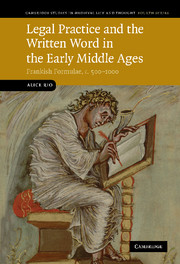Book contents
- Frontmatter
- Contents
- List of tables
- Acknowledgements
- List of abbreviations
- INTRODUCTION
- Part I Formulae, Charters and the Written Word
- Part II Inventory of the Evidence
- Part III Formulae as a Historical Source: Limits and Possibilities
- CONCLUSION
- Appendix A handlist of manuscripts
- Bibliography
- Index
- Manuscript Index
INTRODUCTION
Published online by Cambridge University Press: 14 August 2009
- Frontmatter
- Contents
- List of tables
- Acknowledgements
- List of abbreviations
- INTRODUCTION
- Part I Formulae, Charters and the Written Word
- Part II Inventory of the Evidence
- Part III Formulae as a Historical Source: Limits and Possibilities
- CONCLUSION
- Appendix A handlist of manuscripts
- Bibliography
- Index
- Manuscript Index
Summary
Legal formulae are in an unusual position among early medieval sources. Their study peaked early. It was begun in earnest by the beginning of the seventeenth century, and formulae elicited fairly steady scholarly interest from then on. The nineteenth century was, in historiographical terms, their golden age: rival editions were published, Eugène de Rozière's work was quickly followed and superseded by Karl Zeumer's Monumenta edition, and there was a flurry of debate and controversy regarding dating and editing work, in which French scholars usually reached conclusions diametrically opposed to those of their German counterparts. Fustel de Coulanges relied heavily on formulae as a source in his Monarchie franque, and his work can in some ways be said to represent the only serious attempt to use them comprehensively in a general history on the same level as, for instance, the law-codes or narrative histories. By the 1930s, formulae looked set to become established as a source for the Frankish kingdoms that could not be dispensed with.
Curiously, however, their use declined sharply thereafter. Modern historians have in general been far less sure about exactly what it is that formulae can really tell us, or indeed whether they can be useful at all, and they are now mostly relegated to footnotes, as back-up for points already made on the basis of different sources.
- Type
- Chapter
- Information
- Legal Practice and the Written Word in the Early Middle AgesFrankish Formulae, c.500–1000, pp. 1 - 6Publisher: Cambridge University PressPrint publication year: 2009
- 1
- Cited by

